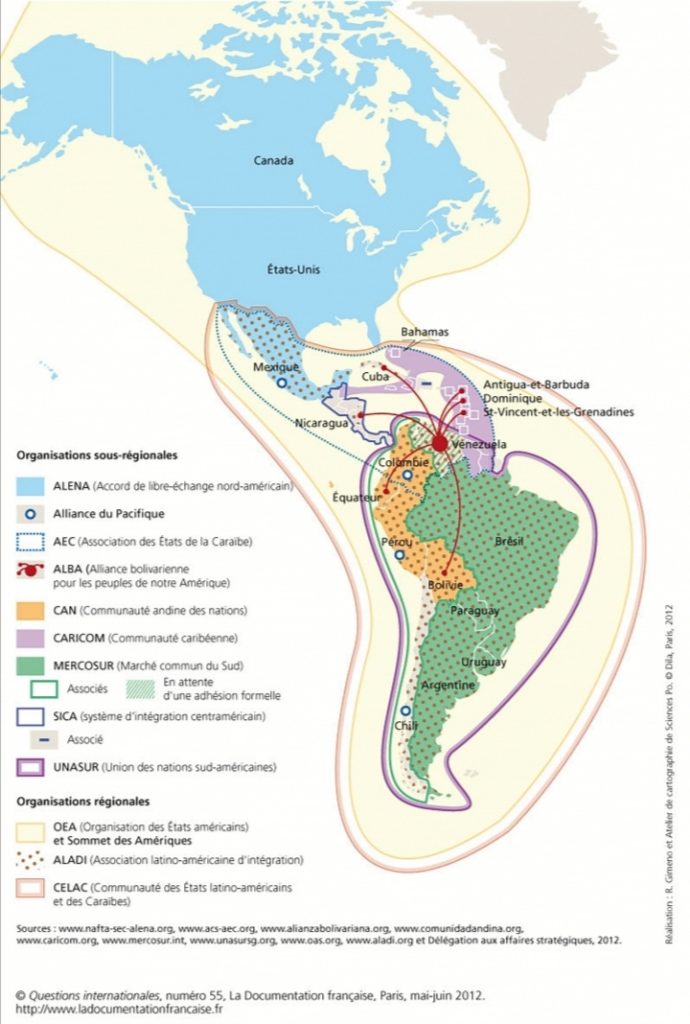By Louikens EVARISTE, Intern Analyst in International Relations and Human Rights at AISP/SPIA, Master’s student in History, Theory, and Practice of Human Rights at the Catholic University of Lyon, under the supervision of the president of AISP/SPIA, Mr. Laurent Attar-Bayrou.
In the context of the post-World War II era, the rapid development of regional organizations is associated with the growing institutionalization of international relations. Addressing a variety of issues, often linked to specialized cooperation agreements within the same geographical contexts, regional organizations create the conditions for constructive cooperation. The issue of collective security is one such issue[1]. Chapter VIII of the UN Charter thus provides a framework for the participation of regional organizations in the maintenance of international peace and security. Some therefore argue that regional integration would facilitate negotiations in regions requiring high levels of coordination and subject to issues requiring integrated approaches.
The proliferation of integration agreements on the American continent in recent decades is proof that regional integration is progressing well there. In addition to the Organization of American States (OAS) as a regional organization, other subregional organizations (UNASUR, CARICOM, ACS, OLADE, CELAC, ECLAC, MERCOSUR, SICA, CAN, ALBA, etc.) have emerged in the region. However, to what extent can this essentially economic integrationist dynamic[3] make progress on regional security issues?

Source: Questions internationales, n°55, La Documentation française, Paris, May-June 2012
In the Americas, the chronic violent disruption of democratic processes and transnational organized crime, among other things, pose major security challenges. As recognized in the 2002 Bridgetown Declaration, the threats, concerns, and other challenges to security on the American continent are diverse in nature and multidimensional in scope. Such situations pose a threat to regional peace and security. However, cooperation in this area has been inconclusive compared to the reality in other regions such as Africa. This is despite summits and forums dedicated to defense and security policy, such as those initiated by the OAS, for example. Yet this is the ambition of this organization, if only at the normative level. Its charter, signed in Bogota in April 1948, has two major objectives: the peaceful resolution of regional disputes and collective security.
A situation in which a violent intra-state or inter-state conflict would not be subject to resolution by a regional organization is difficult to imagine today. Regional organizations therefore remain a priority for conflict prevention and peacekeeping. There is a desire to make the regional level a suitable framework for conflict management. This idea can be linked to the African experience, with the establishment by ECOWAS (Economic Community of West African States) in 1975, ECOMOG (Economic Community of West African States Cease-fire Monitoring Group) in 1990, and the African Union’s initiative to create the African Standby Force (ASF) in 2003. Operational a few years later, the ASF aims to address security challenges on the continent, including terrorism. To illustrate this, we can mention ECOMOG’s intervention in Liberia, which aimed to restore peace in the country in 2003. Some of its results have been encouraging, in our opinion, given the ease of deployment of military personnel and the level of trust established among the African public. May these factors encourage similar ventures in other regions, including the Americas.
On the American continent, cooperation in the military sphere does exist. One example is the common defense and security policy on the continent, overseen by the Permanent Council of the OAS. In practice, however, the Permanent Council acts in this area through the Commission on Hemispheric Security, in parallel with the Inter-American Defense Council. The establishment of a regional force, which would be the ultimate manifestation of regional security integration, is not yet on the agenda. Such an ambition is indeed the subject of much debate. Some, including Neil S. Macfarlane and Thomas G. Weiss, advocate a division of labor between the UN and the OAS in the region, arguing that UN interventions should be prioritized when cooperative security is needed. In other words, it would be preferable not to seek to develop a comprehensive cooperative security apparatus in the Americas immediately, but rather to rely on the support of the UN, which is considered more suited to crisis management. In fact, all military interventions carried out in the name of collective security on the continent are conducted by the UN. However, the participation of the OAS and certain states in the region still has its advantages. For example, the OAS played an important role alongside the UN in the first-ever peacekeeping operation in Haiti in the early 1990s.
However, obstacles remain. First, there are legitimate doubts about the region’s ability to implement appropriate measures in the event of necessary intervention in the most influential states, such as Brazil or Mexico, due to their economic and military power. Furthermore, these states, whose support is essential for the implementation of cooperative security objectives, must assess the risk of one day being the target of a collective military operation, which runs counter to their interests.
Second, from a realistic perspective and for historical reasons, the United States cannot support the regional force project. Historically, American hegemony in the region has been seen as a stumbling block to the realization of regional ambitions for collective security. Recalling the Monroe Doctrine in the early 19th century and the Truman Doctrine in the context of the Cold War, the United States has always positioned itself as the protector of the continent. It should be noted that since the fall of the Communist bloc, Latin America has become increasingly strategic for the United States. Its presence is imposing and essentially military (air, naval, ground forces, intelligence, logistics) in Central America, the Caribbean, and South America.
The relevance of a regional security integration approach lies in preserving the political and cultural specificities of each geographical area. Regional organizations can serve international peace and security, thanks in particular to their proximity to the field and their informed understanding of specific conflict situations. On the American continent, regional actors are generally aware of this. Diplomatic discussions on defense and security issues in the region have led to strategic frameworks, including the Mexico City Declaration on Security in the Americas[11] and the Bridgetown Declaration.
However, geopolitical constraints and the realistic behavior of the Americans discourage more ambitious regionalization of security issues on the continent. Given its considerable weight in the region, the United States cannot allow defense and security policies to materialize that contradict its strategic interests in the region, also taking into account its traditional isolationism in matters of security and defense. More categorically, the approach developed by the OAS is marked by North American foreign policy.
On the other hand, based on a geopolitical division of the Americas inspired by the ideas of Nicholas Spykman, South American momentum in security and defense could be encouraged. This would involve, on the one hand, building a balance of power between North America, Central America, the Caribbean, and South America; and, on the other hand, encouraging South American momentum in security and defense within the framework of the Union of South American Nations (UNASUR). Such a policy, in the best-case scenario, with the effective involvement of Brazil[12][13], could counterbalance North American influence and the unilateral position of the United States.
Sources
[1] DESCHAUX-DUTARD Delphine, Introduction à la sécurité internationale, Grenoble, Presses universitaires de Grenoble, 2018, p. 109.
[2] DABENE Olivier, « L’intégration régionale dans les Amériques », Les études du Centre d’études et de recherches internationales, Centre de recherches internationales de Sciences Po (CERI), 1998, pp.1-47.
[3] Op. Cit.
[4] Déclaration, Declaration of Bridgetown, Organization of American States, 4 Juin 2002, consultable à l’adresse http://www.oas.org/xxxiiga/english/docs_en/docs_items/agcgdoc15_02.htm. [5] Charte, Charte de l’Organisation des États Américains, signée le 30 avril 1948, entrée en vigueur le 13 décembre 1951, consultable à l’adresse : http://www.oas.org/dil/french/traites_A-41_Charte_de_l_Organisation_des_Etats_Americains.htm
[6] Communiqué, Organisation des Nations Unies, Communiqué du 18 janvier 2021, consultable à l’adresse : https://www.un.org/press/fr/2021/sc14413.doc.htm
[7]GNANGUENON Amandine, « La régionalisation africaine ou l’émergence d’un nouveau mode de gestion des conflits ? », Les Champs de Mars, vol. 17, n°1, 2005, pp. 75-99.
[8] S. NEIL Macfarlane, « La Communauté des États indépendants et la sécurité régionale », Études internationales, Québec, 1995, pp 785–797
[9] GOSSELIN Guy, MACE Gordon, BELANGER Louis, « La sécurité coopérative régionale dans les Amériques : le cas des institutions démocratiques », Études internationales, vol. 26, n°4, 1995, 799–817, disponible sur https://doi.org/10.7202/703528ar, consulté le 12 avril 2021. [10] DREYFUS François-Georges, « La doctrine de Monroe, un impérialisme masqué », article, CLIO, www.clio.fr, https://www.clio.fr/bibliotheque/la_doctrine_de_monroe_un_imperialisme_masque.asp, consulté le 11 avril 2021.
[11] Déclaration, Déclaration sur la sécurité dans les Amériques, Organization of American States, 28 octobre 2003, consultable à l’adresse https://www.google.com/url?sa=t&rct=j&q=&esrc=s&source=web&cd=&ved=2ahUKEwif__7emYrwAhXHxoUKHQKvDssQFjAAegQIBBAD&url=https%3A%2F%2Fwww.oas.org%2Fcsh%2FCES%2Fdocumentos%2Fce00339f04.doc&usg=AOvVaw0UKVUW8FnxQbCMHWdWlFqw.
[12] CAETANO DO REGO MONTEIRO Licio, « Géopolitique de la sécurité en Amérique du Sud : le rôle du Brésil et les dilemmes d’une région en transition », L’espace politique, https://journals.openedition.org, https://journals.openedition.org/espacepolitique/4144, consulté le 10 avril 2021 [13] DIALLO Massaër, « L’intégration régionale face aux défis de la sécurité », article, Jaga, jaga.afrique-gouvernance.net, https://jaga.afrique-gouvernance.net/_docs/l_int_gration_r_gionale_face_aux_d_fis_de_la_s_curit_1.pdf, consulté le 10 avril 2021.



